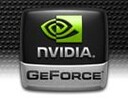Review LG S210-K.CBMAG Notebook
Intel Core 2 Duo T9550 | NVIDIA GeForce 9300M G | 12.10" | 1.8 kg

Enhanced 8400M GS chip, which is manufactured in 65nm and shows slightly better performance due to a few minor optimizations. The technical data correspond to the 8400M GS chip.
A particularity of the graphic card are the "Unified Shaders" or ALUs (Arithmetic Logical Unit). There don't exist any dedicated pixel- or vertex shaders but 16 so called stream processors make the graphic tasks. The advantage is that theoretically there don't exist idle time of the ALUs. The NVIDIA stream processors are 1-dimensional (1D) and are able to accomplish one skalar operation with one MADD-operation (addition and multiplication). Moreover, NVIDIA clocks the shader ALUs somewhat higher than the rest of the chip.
An advantage of the GeForce 9000 series is the integrated PureVideo HD videoprocessor. It helps with the decoding of H.264-, VC-1-, MPEG2- and WMV9 video material in HD quality and therefore reduces the CPU load.
Probably, the memory clock of the GeForce 9300M G depends on the used memory type: 400 MHz with GDDR2 and 600 MHz with GDDR3 were used in 8400M cards.
GeForce 9300M Series
| |||||||
| Codename | NB9M-GS1 | ||||||
| Pipelines | 16 - unified | ||||||
| Core Speed | 400 MHz | ||||||
| Shader Speed | 800 MHz | ||||||
| Memory Speed | 600 MHz | ||||||
| Memory Bus Width | 64 Bit | ||||||
| Memory Type | GDDR2 / GDDR3 | ||||||
| Max. Amount of Memory | 256 MB | ||||||
| Shared Memory | no | ||||||
| API | DirectX 10, Shader 4.0 | ||||||
| Transistor Count | 210 Million | ||||||
| technology | 80 nm | ||||||
| Features | 800 MHZ Shader-clock frequence, PureVideo technology (H.264, VC-1, MPEG2, WMV9 decoder acceleration), HDCP-capable, PowerMizer 7.0 energy management (dynamic switching between performance and energy saving), HDR (High Dynamic-Range Lighting), designed for Windows Vista, 16x full screen AA, 16x AF depending on the angle, 128-bit HDR illumination with AA, PCI-E 16x, OpenGL 2.1, Gigathread technology | ||||||
| Date of Announcement | 01.02.2008 | ||||||
| Link to Manufacturer Page | www.nvidia.com | ||||||
The following benchmarks stem from our benchmarks of review laptops. The performance depends on the used graphics memory, clock rate, processor, system settings, drivers, and operating systems. So the results don't have to be representative for all laptops with this GPU. For detailed information on the benchmark results, click on the fps number.
| low | med. | high | ultra | QHD | 4K | |
|---|---|---|---|---|---|---|
| Crysis - GPU Benchmark | 24.7 | 9 | ||||
| Crysis - CPU Benchmark | 21.6 | 8.6 | ||||
| World in Conflict - Benchmark | 10 | 5 | ||||
| F.E.A.R. | 289 | 57 | 12 | |||
| Doom 3 | 95.7 | 96.1 | 65.2 | 37.5 | ||
| low | med. | high | ultra | QHD | 4K | < 30 fps < 60 fps < 120 fps ≥ 120 fps | 2 1 1 | 3 1 1 | 2 1 | 1 | | |
For more games that might be playable and a list of all games and graphics cards visit our Gaming List
LG S210-K.CBMAG: Intel Core 2 Duo T9550, 12.10", 1.8 kg
External Review » LG S210-K.CBMAG
Sony Vaio VGN-Z56GG: Intel Core 2 Duo P9700, 13.10", 1.5 kg
External Review » Sony Vaio VGN-Z56GG
HP Pavilion dv3000: Intel Core 2 Duo P7350, 13.30", 2.3 kg
External Review » HP Pavilion dv3510nr
Medion MD96970: Intel Core 2 Duo T5750, 15.40", 2.2 kg
External Review » Medion MD96970
Lenovo Thinkpad SL400: Intel Core 2 Duo P8400, 14.10", 2.5 kg
External Review » Lenovo Thinkpad SL400
Asus Lamborghini VX3: Intel Core 2 Duo T9300, 12.10", 1.8 kg
External Review » Asus Lamborghini VX3
Medion MD96630: Intel Pentium Dual Core T2330, 15.40", 2.9 kg
External Review » Medion MD96630
Asus U6S: Intel Core 2 Duo T8300, 12.10", 1.6 kg
External Review » Asus U6S
» Comparison of GPUs
Detailed list of all laptop GPUs sorted by class and performance.
» Benchmark List
Sort and restrict laptop GPUs based on performance in synthetic benchmarks.
» Notebook Gaming List
Playable games for each graphics card and their average FPS results.
Top 10 Laptops
Multimedia, Budget Multimedia, Gaming, Budget Gaming, Lightweight Gaming, Business, Budget Office, Workstation, Subnotebooks, Ultrabooks, Chromebooks
under 300 USD/Euros, under 500 USD/Euros, 1,000 USD/Euros, for University Students, Best Displays
Top 10 Smartphones
Smartphones, Phablets, ≤6-inch, Camera Smartphones